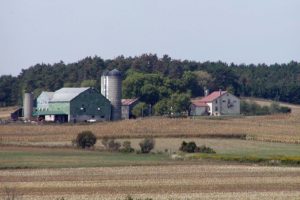 Once again, another study found that being exposed to pesticides has harmful health effects. Of all sorts. A recent study found that pregnant women exposed to certain pesticides increases the risk of a stillbirth. In this case, exposure means living near (less than 1/3 mile) where certain pesticides have been used.
Once again, another study found that being exposed to pesticides has harmful health effects. Of all sorts. A recent study found that pregnant women exposed to certain pesticides increases the risk of a stillbirth. In this case, exposure means living near (less than 1/3 mile) where certain pesticides have been used.
The pesticides linked to increased stillbirths when exposed to in the pre-conception period were: cyfluthrin (a pyrethroid), zeta-cypermethrin (a pyrethroid), pyrethroids as a class, organophosphates as a class, malathion, carbaryl and propamocarb hydrochloride. Exposure in the first trimester of pregnancy to the following pesticides were associated with stillbirths: fenpropathrin (a pyrethroid), permethrin (a pyrethroid), organophosphates as a class, acephate and formetanate hydrochloride.
This means living near a non-organic farm has increased risks to pregnancy and the baby, including stillbirth. Note that some of these are also commonly used residential pesticides, such as pyrethroids (used as insecticides, and especially by mosquito and tick services). We shouldn't be surprised when pesticides applied to kill living things (e.g., insects) also have harmful effects on developing babies (also alive). [Some studies showing harmful effects of pesticides on pregnancy and the developing fetus (baby).]
From Medical Xpress: Pesticide exposure linked to stillbirth risk in new study
Living less than about one-third of a mile from pesticide use prior to conception and during early pregnancy could increase the risk of stillbirths, according to new research led by researchers at the Mel and Enid Zuckerman College of Public Health and Southwest Environmental Health Sciences Center. ...continue reading "Some Pesticides Linked to Increased Risk of Stillbirth"

 Well, well, well...small American organic farms get crushed again. A hazelnut famer sued on behalf of himself and other organic farmers regarding the fact that organic imported foods don't have to meet all the organic requirements that American grown organic foods have to meet. Things like inspections, bookkeeping, and evidence that the foods grown are actually organic.
Well, well, well...small American organic farms get crushed again. A hazelnut famer sued on behalf of himself and other organic farmers regarding the fact that organic imported foods don't have to meet all the organic requirements that American grown organic foods have to meet. Things like inspections, bookkeeping, and evidence that the foods grown are actually organic. Many people in densely populated towns very close to New York City were surprised that they could see the aurora borealis last night. It's usually hard to even see stars because of the light pollution.
Many people in densely populated towns very close to New York City were surprised that they could see the aurora borealis last night. It's usually hard to even see stars because of the light pollution.
 Reduce how much sitting you do each day, by getting off your butt and moving around more. Even if it's just one hour per day. That's what research tells us in how to prevent back pain from worsening in overweight adults.
Reduce how much sitting you do each day, by getting off your butt and moving around more. Even if it's just one hour per day. That's what research tells us in how to prevent back pain from worsening in overweight adults.
 Well.... of course, applying this sludge across farms has now resulted in persistent contamination of both the soil and water at those farms, but also in the animals being raised on those farms. Estimates are up to a
Well.... of course, applying this sludge across farms has now resulted in persistent contamination of both the soil and water at those farms, but also in the animals being raised on those farms. Estimates are up to a 
 Recently, another well done study of vitamin D and cancer resulted in disappointing results. Vitamin D supplements showed no benefit in persons with metastatic colorectal cancer (CRC). It did not result in a difference in overall survival outcomes.
Recently, another well done study of vitamin D and cancer resulted in disappointing results. Vitamin D supplements showed no benefit in persons with metastatic colorectal cancer (CRC). It did not result in a difference in overall survival outcomes.
 For several years I've been reporting on the effects of pesticides on bees. Yes, it's all bad because pesticides kill bees. Commonly used pesticides such as pyrethroids that many view as "safe" kill bees. Pyrethroids are broad spectrum insect killers, which means they kill both beneficial bees and other pollinators, as well as potentially harmful insects (mosquitos).
For several years I've been reporting on the effects of pesticides on bees. Yes, it's all bad because pesticides kill bees. Commonly used pesticides such as pyrethroids that many view as "safe" kill bees. Pyrethroids are broad spectrum insect killers, which means they kill both beneficial bees and other pollinators, as well as potentially harmful insects (mosquitos). Something surprising: People with multiple sclerosis don't develop Alzheimer's disease - even if it runs in the family. New
Something surprising: People with multiple sclerosis don't develop Alzheimer's disease - even if it runs in the family. New